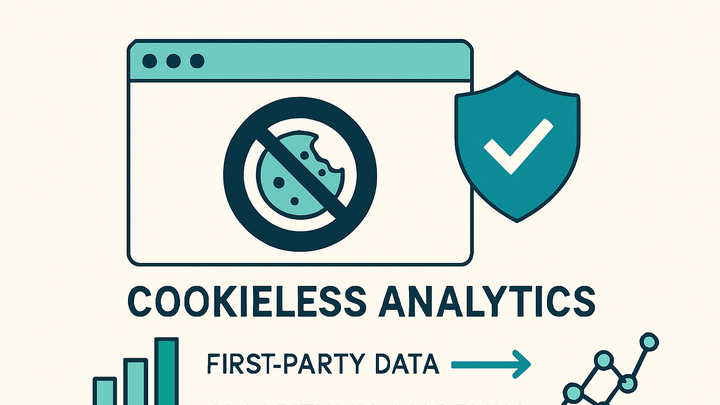Published on 2025-06-26T04:46:41Z
What is Cookieless Analytics? Examples with PlainSignal and GA4
Cookieless analytics is an approach to measuring website and app engagement without relying on traditional browser cookies. It leverages first-party data collection, privacy-preserving algorithms, and server-side tagging to infer user interactions. By avoiding cookies, this methodology aligns with evolving privacy regulations such as GDPR and CCPA, while maintaining reflective and actionable insights. Solutions like PlainSignal exemplify a truly cookie-free analytics platform, and Google Analytics 4 employs machine learning to model missing data. Adopting cookieless analytics helps organizations future-proof their data strategies, improve data resilience, and build user trust by respecting privacy preferences. This approach represents a shifting landscape where accuracy and compliance go hand in hand.
Cookieless analytics
Analytics without cookies using privacy-first methods like first-party data and modeling, ensuring accurate insights while respecting user privacy.
Why Cookieless Analytics Matters
Outlines the drivers behind the shift to cookie-free tracking, including privacy regulations and technical changes.
-
Privacy regulations
Global laws like GDPR, CCPA, and the ePrivacy Directive limit or prevent third-party cookies, pushing companies toward alternative tracking methods.
-
Browser restrictions
Major browsers such as Safari and Firefox block third-party cookies by default, and Chrome is planning similar measures, impacting traditional analytics.
-
User trust and experience
Avoiding cookies can enhance user trust and reduce consent banner friction, leading to better engagement and conversion rates.
How Cookieless Analytics Works
Explains the main techniques enabling analytics without cookies, focusing on first-party data, server-side tagging, and modeling.
-
First-party data collection
Directly gathers user interactions via your domain, such as page views and events, without involving third-party domains. This maintains control and compliance.
-
Privacy-preserving techniques
Techniques like hashing, aggregation, and differential privacy ensure individual user data remains anonymous and secure.
-
Server-side tagging
Processes analytics data on your server before sending it to measurement platforms, reducing reliance on client-side cookies and trackers.
-
Data modeling
Applies statistical and machine learning models to fill gaps when direct measurements are unavailable, similar to GA4’s approach.
Examples of Cookie-Free Analytics Tools
Profiles SaaS products that implement cookieless analytics strategies.
-
PlainSignal
A lightweight, cookie-free analytics tool that provides simple traffic metrics and adheres to privacy regulations without cookies.
-
Google analytics 4
Google’s latest analytics platform that minimizes cookie dependency and uses machine learning to model user behavior when cookies are absent.
Implementation Example
Code snippets showing how to integrate PlainSignal and GA4 in a cookieless compliant manner.
-
PlainSignal tracking code
Embed the following snippet in your HTML to send events without cookies:
<link rel="preconnect" href="//eu.plainsignal.com/" crossorigin /> <script defer data-do="yourwebsitedomain.com" data-id="0GQV1xmtzQQ" data-api="//eu.plainsignal.com" src="//cdn.plainsignal.com/plainsignal-min.js"></script> -
Google analytics 4 snippet
Example GA4 setup with IP anonymization and minimal cookies:
<script async src="https://www.googletagmanager.com/gtag/js?id=G-XXXXXXXXXX"></script> <script> window.dataLayer = window.dataLayer || []; function gtag(){dataLayer.push(arguments);} gtag('js', new Date()); gtag('config', 'G-XXXXXXXXXX', { 'anonymize_ip': true }); </script>
Benefits and Limitations
Balances the advantages and challenges of adopting cookieless analytics.
-
Benefits
Cookieless analytics offers enhanced privacy compliance, reduced dependence on browser policies, and improved user trust.
-
Privacy compliance
Automatically aligns with GDPR and CCPA by design, reducing legal overhead.
-
Future-proofing
Remains resilient against browser cookie blocks and deprecation plans.
-
User trust
Eliminates intrusive cookie banners, fostering a better user experience.
-
-
Limitations
Organizations may face trade-offs in data granularity, reliance on inference, and integration complexity.
-
Data granularity
Some fine-grained metrics may be unavailable without third-party cookies.
-
Modeling accuracy
Statistical inference can introduce estimation errors that need validation.
-
Implementation effort
Requires setup of server-side tagging or new SDKs, which can be complex.
-
Best Practices
Recommendations for effectively deploying cookieless analytics.
-
Combine with server-side tagging
Use server-side endpoints to securely collect and forward analytics data, minimizing client-side dependencies.
-
Leverage first-party context
Customize tracking based on authenticated user sessions, enhancing accuracy without cookies.
-
Monitor data quality
Regularly validate modeled data against known benchmarks to ensure reliability.
-
Stay informed on regulations
Keep up-to-date with privacy laws to ensure continued compliance as regulations evolve.
